What's inside Johnny Buskowiak's footlocker?
A Civilian Conservation Corps member's footlocker was his home-away-from-home. This footlocker belonged to Johnny Buskowiak. Open it and explore!
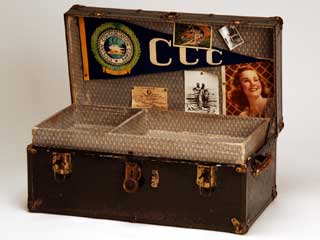
Transcript
The CCC (Civilian Conservation Corps) began in 1933. The program provided jobs to young men in Minnesota’s forests and on farms. To qualify, a man had to be a US citizen between 17 and 23 years of age. They were paid $30 each month with the understanding that $25 would be sent home to help their families. CCC camps were run like military camps. Enrollees were issued uniforms and kept their few belongings in an army-style footlocker. This footlocker belonged to John Buskowiak who worked at the Plainview, Minnesota CCC camp 2709 and later at Lake City. Take a look inside!
Explore the Lid
Pennant
Johnny Buskowiak got this blue felt pennant at the camp's canteen store while stationed with CCC Company 713 at Lake City, Minnesota, in 1940.

MNHS 3D Collections 1993.146.12
Transcript
This would be Lake City, dear old Lake City. I wanted something to indicate that I was in the C’s and something—a memorial of the CC’s and I never dreamt I’d send it to a museum.
Postcard
Mail was an important link to friends and family for the young men in the CCCs. Johnny Buskowiak received this postcard, from Deadwood, South Dakota, in 1940 while stationed with CCC Company 713 at Lake City, Minnesota.
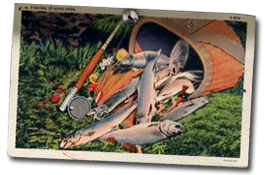
MNHS 3D Collections 1993.146.12
Transcript
Introduction: Many of the young men in the CCC’s were away from home for the first time. Mail from family and friends helped to ease the loneliness. Friends sent this postcard to John Buskowiak at the Lake City camp. Writing letters home was just as important to John.
Memoir excerpt: After we had our evening meal we could have time to ourselves. It was a time where we could sit down and write a letter to mom or to our sweetheart who was waiting for us.
Snapshot of John Buskowiak
Johnny Buskowiak posed for the camera during his time with CCC Company 713, Lake City, Minnesota in 1940. Johnny enjoyed working outside in the summer sun.
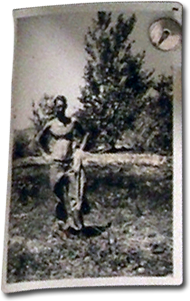
MNHS 3D Collections 1993.146.12
Orientation Training Certificate
CCC enrollees received certificates for passing different levels of training. This certificate reads: “This document certifies that Rafael Buskowiak completed orientation training for CCC Company 713 in April 1940.” “Rafael” is Johnny’s first name.

MNHS 3D Collections 1993.146.12
Transcript
Interviewer: Then we have this orientation certificate too dated April 24, 1940.
John: Right, see when any new group of boys come in you had orientation and then you got a certification for attending this orientation test.
Interviewer: So what’d they do? They took you around the camp…
John: Yes, just took you around the camp and show you the different activities and so forth throughout the whole camp. Yes, that’s right.
Interviewer: So they’d give you this certificate after you finished?
John: Yes.
Snapshot of John Buskowiak and Leonard Johnson
Johnny Buskowiak (left) and Leonard Johnson pose in front of Lake Pepin on the Mississippi River during their service in the CCC at Lake City in 1940.
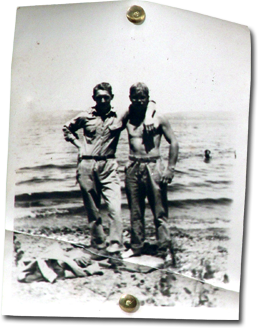
MNHS 3D Collections 1993.146.12
Transcript
Introduction: Men who served in the Civilian Conservation Corps remembered the strong friendships made in camp. This picture shows John Buskowiak and Leonard Johnson at the Lake City camp.
Memoir excerpt: Here I was, just a boy of 16 with other boys as old as 25. I just loved it.
Studio Portrait of Deanna Durbin
Singer and actress Deanna Durbin was one of the most popular young entertainers of the 1930s. Johnny remembered obtaining this portrait of his favorite starlet at the movie theater in Lake City.

MNHS 3D Collections 1993.146.12
Transcript
John: Deanna, where’s Deanna?
Interviewer: Oh there’s Deanna.
John: Deanna right there. She’s beautiful. She’s beautiful, and a beautiful actress too.
Interviewer: Was she your favorite?
John: Yes, she was my favorite I’d say. I bought that at the Lake City theater. I bought it one night there.
Interviewer: So they would sell promotional photos there (right, yes) of the stars?
John: Right, right.
Interviewer: But you would often go and see her movies.
John: Oh yes, I would always go to her movies if I had a chance and if I was free to go, I went.
Explore the Drawer
Transcript
Well I bought the trunk at the—I think I paid $5 for it. $5 is all. We bought all of our material for the CCC’s, for the clothes and shoes and hats and ties and everything else was bought at the Quartermaster’s house, which was located on the campsite. We got all our supplies there. I think I paid $5 for this trunk. This’d be right on the bunk, right underneath the bunk. And everything when I was in the camp there, everything that I could keep in there, I could keep in there.
CCC Uniform Belt
Johnny Buskowiak wore this belt at CCC camps near Plainview and Lake City, Minnesota. The brass buckle is stamped "U.S. J.Q.M.D. 1938," and came from the U.S. Army's massive Jeffersonville Quartermaster Depot in Indiana. Many CCCers were outfitted with surplus military clothing.
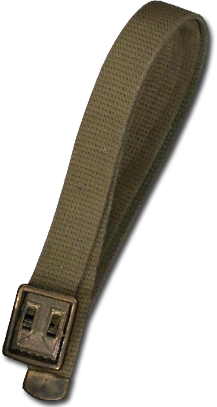
MNHS 3D Collections 1993.146.10
Winter Cap
Richard Loida wore this wool-lined canvas cap while stationed with CCC Company 712 near Grand Marais, Minnesota. The hat provided welcomed warmth at a camp where winter temperatures seldom broke 25 degrees Fahrenheit.
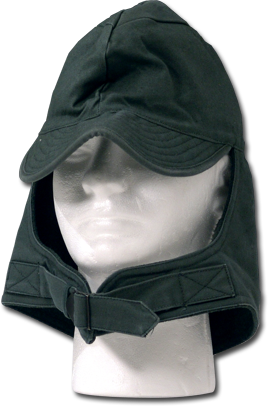
MNHS 3D Collections 65.8.16
Overseas Cap
Richard Loida wore this cap while serving in Company 712 of the CCC near Grand Marais, Minnesota. The hat is in the style of the "overseas" or "garrison" caps worn by U.S. soldiers in World War I. It is a clear example of the military's influence on the CCC.
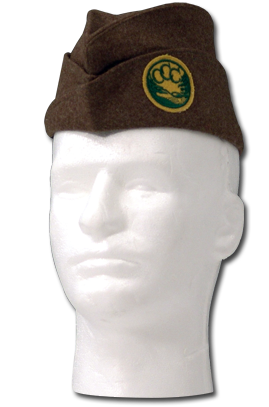
MNHS 3D Collections 65.8.8
Rank Insignia
This set of chevrons indicated Richard Loida's rank as an assistant leader of the CCC Company 712 camp near Grand Marais, Minnesota. Chevrons have long been used in the U.S. armed forces to indicate ranks for enlisted soldiers. Their use in the CCC suggests the military's strong influence on the program.
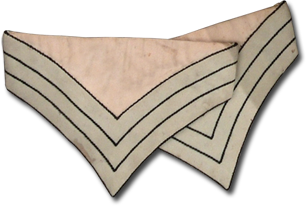
MNHS 3D Collections 65.8.17
Uniform Buttons
Clarence Lundquist used these copper plated steel buttons with CCC Company 1721 at a camp near Isabella, Minnesota.
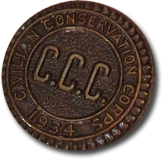

MNHS 3D Collections 1986.127.1.A,B
CCC Uniform Tie
Richard Loida wore this tie as an assistant leader of the CCC Gunflint District, Company 712, camp near Grand Marais, Minnesota.
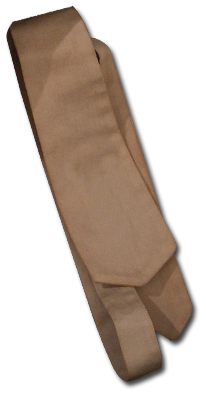
MNHS 3D Collections 65.8.11
Transcript
About a week after I was in camp at Lake City, I got a message from the SCS, the Soil Conservation Office, that the head officer wanted to see me. Well I went to see him and he told me he had heard that I was a pretty good typist. I told him I had two years of typing in high school so I knew I could do it. Well I thought this was pretty neat, I took the job. I started at 8 am and I quit at 5 pm. I was dressed up every day in my suntans with a tie.
Keys
Living in a CCC barracks with other young men meant little personal privacy. These keys for Johnny Buskowiak's footlocker allowed him to lock up his belongings when away from camp.


MNHS 3D Collections 1993.146.12
Explore the Base
Bugle
The Army heavily influenced the CCC. Members awoke, ate and fell asleep to bugle calls. Johnny Buskowiak remembered playing “Taps” each night and hearing it echo across the Lake City camp. This 1898 bugle is of a standard design adopted by the Army in 1892 and still in use today.

MNHS 3D Collections 70.68.6
Transcript
The other thing was the Taps, that’s right. See, I took my trumpet to the camp there and every night at 9:00, I would go out under the flagpole and I’d play the Taps. Oh it was the most beautiful thing because the Taps, you played it across the three miles of Lake City and then it bounced back against hills on the other side and boy, it’d just be beautiful. Ta-ta-TA, ta-ta-TA. And I played the bugle every night at 9:00 underneath the flag. Oh boy, that was beautiful. Yes, you bet. And then the lights would go off right, and it was done.
Canteen Book
Snacks and other items could be purchased at the camp canteen using coupons from books, like those pictured. John Buskowiak (1922-2008) used these coupon books while serving in the CCC in Plainview and Lake City.
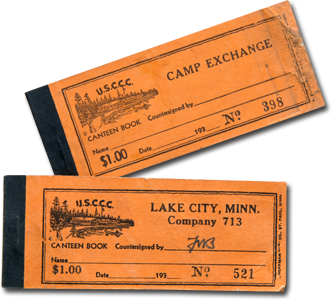
MNHS 3D Collections 1993.146.3,4
Transcript
Interviewer: I found these canteen books in your collection here.
John: And they’re made up of ten 10 cent coupons each and we could just go in and tear off a coupon and buy a pack of cigarettes or—cigarettes were 10 cents then you know. I’d buy one book at a time. One book at a time that’d give me ten, see, and 10 cents was ice cream or 10 cents for shoelaces or something like that I wanted to buy at the canteen. That’s what I’d do.
Interviewer: So they didn’t take the money, they wanted the coupons?
John: They’d take the coupons, right.
Overcoat
Joseph Spitznagle wore this heavy wool overcoat with the CCC between 1933 and 1942. The CCC's work continued year-round. In fact, winter cold and snow provided ideal conditions for controlled forest burns. These burns eliminated flammable brush and reduced the risk of summer forest fires.
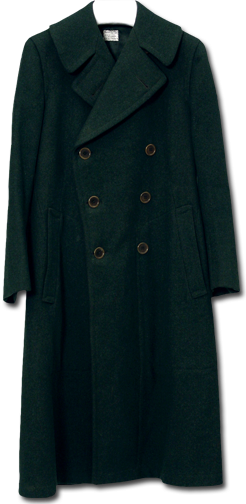
MNHS 3D Collections 9408.1.C



 Home
Home Lid
Lid Drawer
Drawer Base
Base